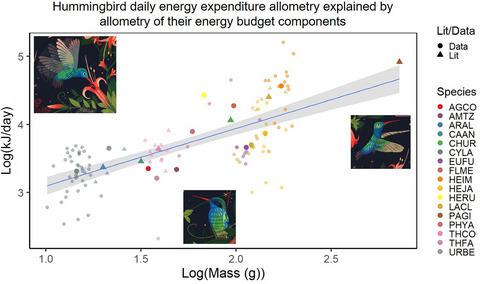当前位置:
X-MOL 学术
›
J. Anim. Ecol.
›
论文详情
Our official English website, www.x-mol.net, welcomes your
feedback! (Note: you will need to create a separate account there.)
The allometry of daily energy expenditure in hummingbirds: an energy budget approach
Journal of Animal Ecology ( IF 3.5 ) Pub Date : 2020-02-28 , DOI: 10.1111/1365-2656.13185 Anusha Shankar 1 , Donald R Powers 2 , Liliana M Dávalos 1 , Catherine H Graham 1, 3
Journal of Animal Ecology ( IF 3.5 ) Pub Date : 2020-02-28 , DOI: 10.1111/1365-2656.13185 Anusha Shankar 1 , Donald R Powers 2 , Liliana M Dávalos 1 , Catherine H Graham 1, 3
Affiliation

|
Within-clade allometric relationships represent standard laws of scaling between energy and size, and their outliers provide new avenues for physiological and ecological research. According to the metabolic level boundaries hypothesis, metabolic rates as a function of mass are expected to scale closer to 0.67 when driven by surface-related processes (e.g., heat or water flux), while volume-related processes (e.g., activity) generate slopes closer to one. In birds, daily energy expenditure (DEE) scales with body mass (M) in the relationship log (DEE) = 2.35 + 0.68 * log (M), consistent with surface-level processes driving the relationship. However, taxon-specific patterns differ from the scaling slope of all birds. Hummingbirds have the highest mass-specific metabolic rates among all vertebrates. Previous studies on a few hummingbird species, without accounting for the phylogeny, estimated that the DEE-body mass relationship for hummingbirds was log (DEE) = 1.72 + 1.21 * log (M). Contrary to theoretical expectations, this slope greater than 1 indicates that larger hummingbirds are less metabolically efficient than smaller hummingbirds. We collected DEE and mass data for 12 hummingbird species, which, combined with published data, represented 17 hummingbird species in eight of nine hummingbird clades over a six-fold size range of body size (2.7 - 17.5 g). After accounting for phylogenetic relatedness, we found daily energy expenditure scales with body mass as log (DEE) = 2.04 + 0.95 * log (M). This slope of 0.95 is lower than previously estimated for hummingbirds, but much higher than the slope for all birds (0.68). The high slopes of torpor, hovering and flight potentially explain the high interspecific DEE slope for hummingbirds compared to other endotherms.
中文翻译:

蜂鸟每日能量消耗的异速生长:能量预算方法
进化枝内异速生长关系代表了能量和大小之间的标准缩放规律,它们的异常值为生理学和生态学研究提供了新的途径。根据代谢水平边界假设,当由表面相关过程(例如,热量或水通量)驱动时,作为质量函数的代谢率预计将接近 0.67,而体积相关过程(例如,活动)会产生斜率更接近一个。在鸟类中,每日能量消耗 (DEE) 在关系日志 (DEE) = 2.35 + 0.68 * log (M) 中与体重 (M) 成比例,这与驱动关系的表面水平过程一致。然而,特定于分类群的模式不同于所有鸟类的缩放斜率。蜂鸟在所有脊椎动物中具有最高的特定质量代谢率。以前对一些蜂鸟物种的研究,在不考虑系统发育的情况下,估计蜂鸟的 DEE 体重关系为 log (DEE) = 1.72 + 1.21 * log (M)。与理论预期相反,该斜率大于 1 表明较大蜂鸟的代谢效率低于较小蜂鸟。我们收集了 12 种蜂鸟的 DEE 和质量数据,结合已发表的数据,代表了 9 个蜂鸟进化枝中的 8 个中的 17 种蜂鸟物种,体型大小为六倍(2.7 - 17.5 克)。考虑到系统发育相关性后,我们发现每日能量消耗量表与体重为 log (DEE) = 2.04 + 0.95 * log (M)。这个 0.95 的斜率低于之前对蜂鸟的估计,但远高于所有鸟类的斜率 (0.68)。麻木的高坡,
更新日期:2020-02-28
中文翻译:

蜂鸟每日能量消耗的异速生长:能量预算方法
进化枝内异速生长关系代表了能量和大小之间的标准缩放规律,它们的异常值为生理学和生态学研究提供了新的途径。根据代谢水平边界假设,当由表面相关过程(例如,热量或水通量)驱动时,作为质量函数的代谢率预计将接近 0.67,而体积相关过程(例如,活动)会产生斜率更接近一个。在鸟类中,每日能量消耗 (DEE) 在关系日志 (DEE) = 2.35 + 0.68 * log (M) 中与体重 (M) 成比例,这与驱动关系的表面水平过程一致。然而,特定于分类群的模式不同于所有鸟类的缩放斜率。蜂鸟在所有脊椎动物中具有最高的特定质量代谢率。以前对一些蜂鸟物种的研究,在不考虑系统发育的情况下,估计蜂鸟的 DEE 体重关系为 log (DEE) = 1.72 + 1.21 * log (M)。与理论预期相反,该斜率大于 1 表明较大蜂鸟的代谢效率低于较小蜂鸟。我们收集了 12 种蜂鸟的 DEE 和质量数据,结合已发表的数据,代表了 9 个蜂鸟进化枝中的 8 个中的 17 种蜂鸟物种,体型大小为六倍(2.7 - 17.5 克)。考虑到系统发育相关性后,我们发现每日能量消耗量表与体重为 log (DEE) = 2.04 + 0.95 * log (M)。这个 0.95 的斜率低于之前对蜂鸟的估计,但远高于所有鸟类的斜率 (0.68)。麻木的高坡,











































 京公网安备 11010802027423号
京公网安备 11010802027423号